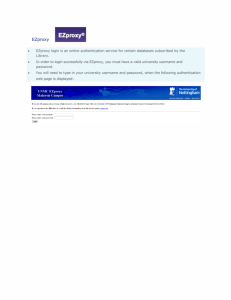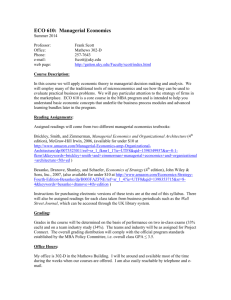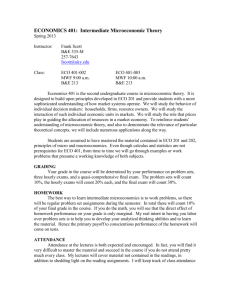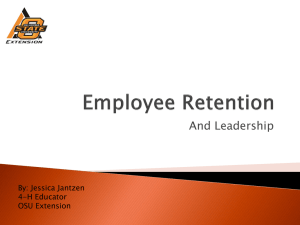Syllabus - Gatton College of Business and Economics
advertisement
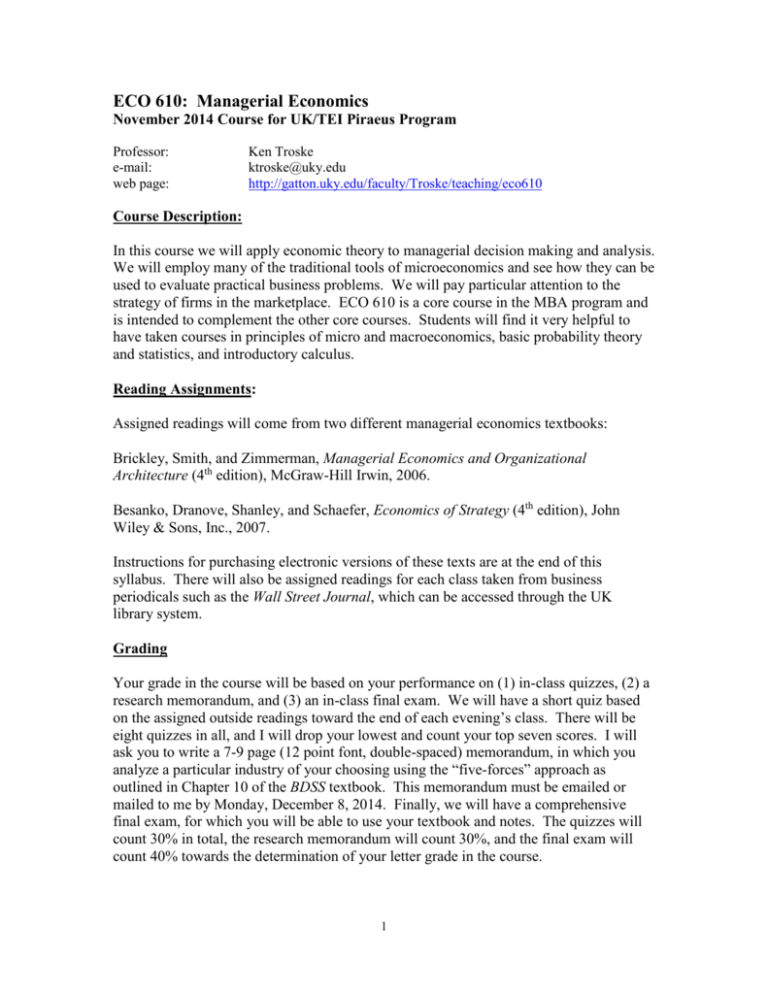
ECO 610: Managerial Economics November 2014 Course for UK/TEI Piraeus Program Professor: e-mail: web page: Ken Troske ktroske@uky.edu http://gatton.uky.edu/faculty/Troske/teaching/eco610 Course Description: In this course we will apply economic theory to managerial decision making and analysis. We will employ many of the traditional tools of microeconomics and see how they can be used to evaluate practical business problems. We will pay particular attention to the strategy of firms in the marketplace. ECO 610 is a core course in the MBA program and is intended to complement the other core courses. Students will find it very helpful to have taken courses in principles of micro and macroeconomics, basic probability theory and statistics, and introductory calculus. Reading Assignments: Assigned readings will come from two different managerial economics textbooks: Brickley, Smith, and Zimmerman, Managerial Economics and Organizational Architecture (4th edition), McGraw-Hill Irwin, 2006. Besanko, Dranove, Shanley, and Schaefer, Economics of Strategy (4th edition), John Wiley & Sons, Inc., 2007. Instructions for purchasing electronic versions of these texts are at the end of this syllabus. There will also be assigned readings for each class taken from business periodicals such as the Wall Street Journal, which can be accessed through the UK library system. Grading Your grade in the course will be based on your performance on (1) in-class quizzes, (2) a research memorandum, and (3) an in-class final exam. We will have a short quiz based on the assigned outside readings toward the end of each evening’s class. There will be eight quizzes in all, and I will drop your lowest and count your top seven scores. I will ask you to write a 7-9 page (12 point font, double-spaced) memorandum, in which you analyze a particular industry of your choosing using the “five-forces” approach as outlined in Chapter 10 of the BDSS textbook. This memorandum must be emailed or mailed to me by Monday, December 8, 2014. Finally, we will have a comprehensive final exam, for which you will be able to use your textbook and notes. The quizzes will count 30% in total, the research memorandum will count 30%, and the final exam will count 40% towards the determination of your letter grade in the course. 1 Class Structure Since this course is so compact and concentrated, we have to be very efficient in our use of class time. Also, I recognize that many students will have already put in a full day at work before coming to class. We will typically break each evening into three sessions. In the first session, from 6:00 p.m. until 7:15, I will introduce the evening’s topic and provide some examples to motivate interest. After a fifteen-minute break, I will provide further theoretical discussion of the topic. The second session will typically last from 7:30 until 8:45. After another fifteen-minute break, we will finish off the evening with an hour-long discussion of cases and applications, ending class at 10:00 p.m. Each evening’s short quiz will typically come at the end of the second session. Course Outline and Reading Assignments: Monday, November 10: Introduction, basics of market systems, demand and supply analysis. Text: BSZ, ch. 3, “Markets, Organizations, and the Role of Knowledge.” Outside readings: “Tempur-Pedic stock up after report, analysis,” Lexington Herald-Leader, 7/26/12, p. B5: http://www.kentucky.com/2012/07/25/2270718/tempur-pedic-stock-up-after2q.html “China’s Winter of Discontent,” WSJ, 3/14/06. http://ezproxy.uky.edu/login?url=http://search.proquest.com/docview/398959819 ?accountid=11836 “Lawmakers struggle to define gasoline price ‘gouging,’” WSJ, 11/9/05. http://ezproxy.uky.edu/login?url=http://search.proquest.com/docview/398991187 ?accountid=11836 “Corn’s Rally Sends Ripples,” WSJ, 1/18/07. http://ezproxy.uky.edu/login?url=http://search.proquest.com/docview/398983538 ?accountid=11836 “Price Controls Keep Venezuela Cupboards Bare,” New York Times, 4/12/2012 http://www.lexisnexis.com/lnacui2api/api/version1/getDocCui?lni=55FV-9F91JBG361S9&csi=6742&hl=t&hv=t&hnsd=f&hns=t&hgn=t&oc=00240&perma=true Tuesday, November 11: Production, economic costs, economic profit. Text: BSZ, ch. 5: “Production and cost.” Outside readings: “Holiday Hiring Call: People vs. Robots,” WSJ, 12/20/10. http://ezproxy.uky.edu/login?url=http://search.proquest.com/docview/818622450 ?accountid=11836 “Honda’s Flexible Plants Provide Edge,” WSJ, 9/23/08. 2 http://ezproxy.uky.edu/login?url=http://search.proquest.com/docview/399105360 ?accountid=11836 “Small Talk,” WSJ, 5/30/06. http://ezproxy.uky.edu/login?url=http://search.proquest.com/docview/399047133 ?accountid=11836 “Small Investments with Major Returns,” WSJ, 1/5/09. http://online.wsj.com/article/SB123116077359153453.html “With Farm Robotics, the Cows Decide When It’s Milking Time,” New York Times, 4/22/2014. http://www.lexisnexis.com/lnacui2api/api/version1/getDocCui?lni=5C1X-XDH1DXY4X364&csi=6742&hl=t&hv=t&hnsd=f&hns=t&hgn=t&oc=00240&perma=true Individual assignment: take online virtual plant tours of Toyota’s Georgetown manufacturing facility (http://www.youtube.com/watch?v=5a5ewV_2fwk) and Purity Dairy’s dairy processing facility (http://www.puritydairies.com/company/tour/index.html). Wednesday, November 12: Horizontal boundaries of the firm—economies of scale and scope, diseconomies of size, the learning curve. Text: BDSS, ch. 2: “The Horizontal Boundaries of the Firm: Economies of Scale and Scope.” Outside readings: “Power Pork: Corporations Begin to Turn Hog Business into an Assembly Line,” WSJ, 3/28/94. http://ezproxy.uky.edu/login?url=http://search.proquest.com/docview/398373847 ?accountid=11836. If you want to see a pork processing plant in action, try http://www.youtube.com/watch?v=LsEbvwMipJI “Meet the World’s Largest Cargo Ships,” WSJ, 1/8/13. http: //ezproxy.uky.edu/login?url=http://search.pro quest.com/docview/1266990140/13FBAE3E923680778EB/71?accountid=11836 “Going to the Well: A Powerful Idea,” Lexington Herald-Leader, 7/4/11. http://bit.ly/nHKQQA Thursday, November 13: Vertical boundaries of the firm—make or buy, transactions costs, asset specificity, hold-up, vertical control devices. Text: BDSS, ch. 3: “The Vertical Boundaries of the Firm.” Outside readings: “Made to Measure: Invisible Supplier Has Penney’s Shirts All Buttoned Up,” WSJ, 9/11/03. http://ezproxy.uky.edu/login?url=http://search.proquest.com/docview/398953831 ?accountid=11836 “Companies More Prone to Go ‘Vertical,’” WSJ, 11/30/09. http://ezproxy.uky.edu/login?url=http://search.proquest.com/docview/399140920 ?accountid=11836 3 “Boeing Tightens Its Grip on Dreamliner Production,” WSJ, 7/2/09. http://search.proquest.com/docview/399125788/7C73947557E04D63PQ/46?acco untid=11836 “An Amazon-Disney Dispute Erupts --- In Echo of Hachette Fight, E-Commerce Giant Not Allowing Customers to Pre-Order Some Movies.” WSJ 8/11/2014. http://search.proquest.com/docview/1552338319/6FEEC586ADED410FPQ/77?ac countid=11836 Friday, November 14: Competitors and competition—defining a market, elements of market structure, types of market structure, perfectly competitive markets. Text: BDSS, ch. 6, “Competitors and Competition.” Outside readings: “Winds of Change for Boeing, Airbus,” WSJ, 3/16/10. http://ezproxy.uky.edu/login?url=http://search.proquest.com/docview/399095358 ?accountid=11836 “Show Stopper: How Plastic Popped the Cork Monopoly,” WSJ, 5/1/10. http://ezproxy.uky.edu/login?url=http://search.proquest.com/docview/220157523 ?accountid=11836 “Alligator Farming Shows There’s a Lot to be Said for Cows,” WSJ, 8/2/89. http://ezproxy.uky.edu/login?url=http://search.proquest.com/docview/398158016 ?accountid=11836 “Economic Woes Take a Bite out of Alligator Ranching,” WSJ, 11/12/97. http://ezproxy.uky.edu/login?url=http://search.proquest.com/docview/398605851 ?accountid=11836 “A Run on Alligators Sends Designers Scrambling,” WSJ, 3/18/06. http://ezproxy.uky.edu/login?url=http://search.proquest.com/docview/399057549 ?accountid=11836 “A Crocodile's Bumpy Road From Farm to Handbag,” Bloomberg Businessweek, 10/24/2013. http://www.businessweek.com/articles/2013-10-24/a-crocodiles-bumpy-roadfrom-farm-to-handbag Saturday, November 15, Sunday, November 16 and Monday, November 17: catch up on reading, work on industry study. Tuesday, November 18: Monopoly, monopolistic competition, pricing with market power. Text: BSZ, ch. 6, “Market Structure.” BSZ, ch. 7, “Pricing with Market Power.” Outside readings: “How a Fight Over a Board Game Monopolized an Economist’s Life,” WSJ, 10/20/09. 4 http://ezproxy.uky.edu/login?url=http://search.proquest.com/docview/399064057 ?accountid=11836 “Seeking Fame in Apple’s Sea of Apps,” WSJ, 7/15/09. http://ezproxy.uky.edu/login?url=http://search.proquest.com/docview/399087647 ?accountid=11836 “Seeking Perfect Prices, CEO Tears Up the Rules,” WSJ, 3/27/07. http://ezproxy.uky.edu/login?url=http://search.proquest.com/docview/399036795 ?accountid=11836 Individual assignment: go to http://disneyworld.disney.go.com/wdw/index and check out Disney World’s pricing strategy for its theme parks, resort hotels, special events, etc. Also visit your favorite airline’s web site, e.g. http://www.delta.com/home/index.jsp, and analyze pricing for air travel and vacation packages. Wednesday, November 19 and Thursday, November 20: Oligopoly, rivalry, strategic behavior, game theory. Text: BSZ, ch. 6, “Market Structure.” BSZ, ch. 9, “Economics of Strategy: Game Theory.” Outside readings: “Haven’t Shareholders Had Enough Chicken?” WSJ, 4/4/01. http://ezproxy.uky.edu/login?url=http://search.proquest.com/docview/398780117 ?accountid=11836 “Cruise Lines Slash Their Prices as War Fears Rattle Travelers,” WSJ, 1/29/03. http://online.wsj.com/article/SB1043780266145632024.html “Upstart’s Tactics Allow it to Fly in Friendly Skies of a Big Rival,” WSJ, 6/23/99. http://ezproxy.uky.edu/login?url=http://search.proquest.com/docview/398729938 ?accountid=11836 “Techdom’s Two Cold Wars,” WSJ, 7/22/09. http://ezproxy.uky.edu/login?url=http://search.proquest.com/docview/399099640 ?accountid=11836 Friday, November 21: Industry analysis—Porter’s five forces, in-class application of five-force analysis to selected Greek industries. Text: BDSS ch. 10: “Industry Analysis,” pp. 312-320, 337-339. Outside Readings: “Greece Fights to Raise Its Wine Image,” WSJ, 08/06/2003. http://search.proquest.com/docview/398942861/762CA604B28F4FAFPQ/10?account id=11836 “Growing Pains: To Bag China’s Snack Market, Pepsi Takes Up Potato Farming,” WSJ, 12/19/05. http://search.proquest.com/docview/399045768/6C3B3F05D1004716PQ/26?accounti d=11836 Thursday, November 27: Final exam. Details to be provided later 5 Instructions for Purchasing Electronic Textbooks: While the electronic textbooks are from the 4th edition of each book, you may be able to find a different edition online for a cheaper price. That should work equally well. Brickley, Smith, and Zimmerman, Managerial Economics and Organizational Architecture (4th edition), McGraw-Hill Irwin, 2007: Click on https://create.mcgraw-hill.com/shop/#/catalog/details/?isbn=9781121597365 Buy the book. Besanko, Dranove, Shanley, and Schaefer, Economics of Strategy (4th edition), John Wiley & Sons, Inc., 2007: Go to: http://coursepacks.xanedu.com/?PackId=472818 If you have previously registered for another CoursePack, log in. If not, click the Student Registration link. Complete the registration page and click Submit. Confirm your CoursePack selection and click Continue. Complete your billing information, confirm and click Submit. After completing the purchase pages, you will be taken to your CoursePack. If you have problems, contact XanEdu Customer Service at 1-800-218-5971 (option 4) or email cust.serv@xanedu.com. 6 Instructions for Industry Analysis Assignment A major (30%) portion of your grade in this course will come from your analysis of a particular industry of your choosing. Your assignment is to select an industry that you have some interest in, and to research that industry so that you become something of an expert. Sources that you might use for your research include library and internet resources, as well as discussions with persons knowledgeable about the industry. Your research should follow the outline of an industry study discussed in Chapter 10 of Economics of Strategy by Besanko, Dranove, Shanley, and Schaefer. In other words, you should do a five-forces analysis of your industry. The types of questions you should consider in analyzing your industry are outlined in Appendix 10.1 of the BDSS textbook. Your challenge is to figure out which questions are most relevant to your chosen industry and hence deserving of your attention, and which ones are not particularly important. You should convey your research findings in a business-style memorandum. Imagine that you have been given the assignment to research a particular industry because a large corporation (your client or employer) is thinking about investing in this industry. You should write a seven-to-nine page memorandum (12 pt. font, doublespaced, one-inch margins) addressed to the executive committee. Make sure that you appropriately cite all of the outside references that you use, because the company will not want to make an important decision based on unreliable sources or flimsy evidence and research. It is very important that you attach as an appendix to your memorandum a copy of each of the sources that you use. If you cite a book or long article, only include the title page and the pages you refer to in your report. For short articles from periodicals, newspapers, and internet sources, include the entire piece. If you interview a person knowledgeable about the industry, explain who the person is and include a summary of your notes from the interview. Then in writing your memo you can use very brief citations to your sources, e.g. see Appendix, Reference A-1, A-2, etc. If you are sending me your report electronically you will need to scan all your sources into an electronic format. This assignment is due Monday, December 8, 2014. That means that you should email or mail it on or before that date to: Professor Kenneth Troske Gatton College of Business and Economics University of Kentucky Lexington, KY 40506-0034 USA E-mail: ktroske@uky.edu 7 My preference is for you to send it by email. If you do send it via regular mail make sure that your packet has a date stamped on it so that I will know that you mailed it on time. 8
